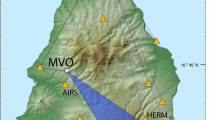Abstract
Refractivity depends on meteorological parameters such as temperature and water vapour pressure and can be measured using a weather radar. A realistic atmospheric simulation from the Meso-NH numerical model is used in order to describe and establish the relation between refractivity and the dynamic and thermodynamic phenomena responsible for the development and propagation of convection. These investigations lead to discussion of the complementarity between the refractivity and the convective available potential energy. The relation observed between the refractivity signal and the meteorological parameters calls the refractivity measurement into question, since it is based on phase differentiation with time and space and can be degraded by phase aliasing problems. These aliasing problems increase with the radar frequency (perceptible in the S-band, serious in the C-band, and more serious in the X-band) and also with the integration range and sampling time. Thus, a statistical approach permits us to simulate the possibility of measuring the refractivity with operational radar during convective events. A typical case in the south-east region of France is selected to simulate measurements by radar (S-band, C-band, X-band) in convective systems, in order to evaluate the measurement feasibility, particularly in terms of phase ambiguity, related to temporal and spatial sampling, of a future implementation of the refractivity measurement over the French operational radar network. This numerical statistical approach is completed with a similar study using in-situ measurements performed at the Trappes station. The seasonal and diurnal dependencies of aliasing are investigated, leading to clarification of the impact of the turbulent fluxes on the refractivity measurement.
Similar content being viewed by others
References
Bean BR, Dutton EJ (1968) Radio meteorology. National Bureau of Standards Monograph, 92. National Bureau of Standards, Washington, 435 pp
Boudjabi C, Parent du Châtelet J (2009) Evaluation of phase ambiguity problem due to sampling time when measuring refractivity with precipitation radar. In: 34th International conference on radar meteorology, Williamsburg, VA, USA. American Meteorological Society
Demoz B, Flamant C, Weckwerth T, Whiteman D, Evans K, Fabry F, Di Girolamo P, Miller D, Geerts B, Brown W, Schwemmer G, Gentry B, Felts W, Wang Z (2006) The dryline on 22 May 2002 during IHOP_2002: convective-scale measurements at the profiling site. Mon Weather Rev 134: 294–310
Ducrocq V, Ricard D, Lafore J-P, Orain F (2002) Storm-scale numerical rainfall prediction for five precipitating events over France: on the importance of the initial humidity field. Weather Forecast 17: 1236–1256. doi:10.1175/1520-0434(2002)017<1236:SSNRPF>2.0.CO;2
Duffourg F, Ducrocq V (2011) Origin of the moisture feeding the northwestern Mediterranean heavy precipitating systems. Nat Hazards Earth Syst Sci 11: 1163–1178. doi:10.5194/nhess-11-1163-2011
Fabry F (2004) Meteorological value of ground target measurements by radar. J Atmos Ocean Technol 21: 560–573
Fabry F (2006) The spatial variability of moisture in the boundary layer and its effect on convection initiation: project-long characterization. Mon Weather Rev 134: 79–91
Fabry F, Frush C, Zawadzki I, Kilambi A (1997) On the extraction of near-surface index of refraction using radar phase measurements from ground targets. J Atmos Ocean Technol 14: 978–987
Houze RA (2004) Mesoscale convective systems. Rev Geophys 42: RG4003. doi:10.1029/2004RG000150
Lafore J-P, Stein J, Asencio N, Bougeault P, Ducrocq V, Duron J, Fischer C, Hereil P, Mascart P, Pinty J-P, Redelsperger J-L, Richard E, Vila-Gueraude Arellano J (1998) The Meso-NH atmospheric simulation system. Part I: Adiabatic formulation and control simulations. Ann Geophys 16: 90–109
Moncrieff MW, Miller MJ (1976) The dynamics and simulation of tropical cumulonimbus and squall lines. Q J Roy Meteorol Soc 120: 373–394
Nuissier O, Ducrocq V, Ricard D, Lebeaupin C, Anquetin S (2008) A numerical study of three catastrophic precipitating events over southern France. I: Numerical framework and synoptic ingredients. Q J Roy Meteorol Soc 134: 111–130. doi:10.1002/qj.200
Parent du Châtelet J, Boudjabi C (2008) A new formulation for a signal reflected from a target using a magnetron radar. Consequences for Doppler and refractivity measurements. In: 5th European conference on radar in meteorology and hydrology (ERAD), Helsinki, Finland
Pradier S, Chong M, Roux F (2002) Radar observations and numerical modeling of a precipitating line during MAP IOP 5. Mon Weather Rev 11: 2533–2553
Seity Y, Brousseau P, Malardel S, Hello G, Bénard P, Bouttier F, Lac C, Masson V (2011) The AROME-France convective scale operational model. Mon Weather Rev 139: 976–991. doi:10.1175/2010MWR3425.1
Simpson J (1980) Downdrafts as linkages in dynamic cumulus seeding effects. J Appl Meteorol 19: 477–487
Smith EK Jr, Weintraub S (1953) The constants in the equation for atmospheric refractive index at radio frequencies. Proc IRE 41: 1035–1037
Sun J (2005) Convective-scale assimilation of radar data: progress and challenges. Q J Roy Meteorol Soc 131: 3439–3463
Taylor GI (1938) The spectrum of turbulence. Proc Roy Soc Lond A 164: 476–490. doi:10.1098/rspa.1938.0032
Tompkins AM (2001) Organization of tropical convection in low vertical wind shears: the role of water vapor. J Atmos Sci 58: 529–545
Vié B, Nuissier O, Ducrocq V (2011) Cloud-resolving ensemble simulations of Mediterranean heavy precipitating events: uncertainty on initial conditions and lateral boundary conditions. Mon Weather Rev 139: 403–423. doi:10.1175/2010MWR3487.1
Wakimoto RM, Murphey HV (2010) Frontal and radar refractivity analyses of the dryline on 11 June 2002 during IHOP. Mon Weather Rev 138: 228–241
Weckwerth TM, Pettet CR, Fabry F, Park S, Lemone MA, Wilson JW (2005) Radar refractivity retrieval: validation and application to short-term forecasting. J Appl Meteorol 44: 285–300
Zipser EJ (1977) Mesoscale and convective-scale downdraughts as distinct components of squall-line circulation. Mon Weather Rev 105: 1568–1589
Author information
Authors and Affiliations
Corresponding author
Rights and permissions
About this article
Cite this article
Besson, L., Boudjabi, C., Caumont, O. et al. Links Between Weather Phenomena and Characteristics of Refractivity Measured by Precipitation Radar. Boundary-Layer Meteorol 143, 77–95 (2012). https://doi.org/10.1007/s10546-011-9656-7
Received:
Accepted:
Published:
Issue Date:
DOI: https://doi.org/10.1007/s10546-011-9656-7




